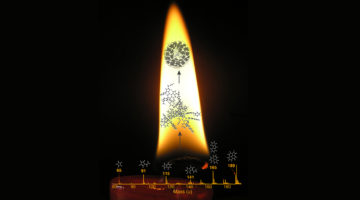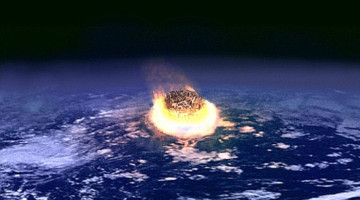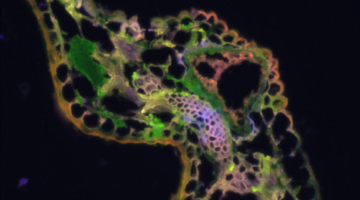Scientists identified a mechanism for the formation of soot involving a series rapid chemical reactions rather than the typical condensation of particles from gas. The results are critical to developing methods for controlling emissions responsible for millions of deaths annually, severe degradation of air quality, and enhanced global warming. Read more »![]()
![]()
Scientists Present New Clues to Cut Through the Mystery of Titan’s Atmospheric Haze
Saturn’s largest moon, Titan, has a nitrogen-rich atmosphere, the formation of which has been the source of some scientific debate. Researchers have zeroed in on a low-temperature chemical mechanism that may have driven the formation of multiple-ringed molecules—the precursors to more complex chemistry now found in the moon’s brown-orange haze layer. Read more »
From Moon Rocks to Space Dust: Berkeley Lab’s Extraterrestrial Research
Berkeley Lab has a well-storied expertise in exploring samples of extraterrestrial origin. This research—which has helped us to understand the makeup and origins of objects within and beyond our solar system—stems from long-standing core capabilities in structural and chemical analyses and measurement at the microscale and nanoscale. Read more »
Chemical Sleuthing Unravels Possible Path to the Formation of Life’s Building Blocks in Space
Experiments retrace the steps leading to the creation of complex hydrocarbons in space, showing pathways to forming 2D carbon-based nanostructures in a mix of heated gases. The study could help explain the presence of pyrene, a polycyclic aromatic hydrocarbon, and similar compounds in some meteorites. Read more »
Unraveling the Complexities of Auto-Oxidation
Researchers directly observed the formation of highly oxygenated molecules—the elusive products of auto-oxidation reactions relevant to combustion and atmospheric chemistry. A better understanding of auto-oxidation mechanisms could lead to better engines, less air pollution, and improved climate models. Read more »![]()
![]()
Formation of Toxic Furans during Combustion
Researchers predicted and observed for the first time the formation and growth of furans and other oxygenated hydrocarbons produced during combustion. These compounds can have a wide range of detrimental effects on human health, air quality, and regional and global climate. Read more »
Manganese Reduction-Oxidation Drives Plant Debris Decomposition
ALS research has shown that manganese reduction-oxidation (redox) reactions are an important factor in controlling the rate of plant debris decomposition. Understanding the role of manganese will help build better models to predict how litter decomposition rates—and thus nutrient cycling and the ecosystem carbon balance—may behave in future climate scenarios. Read more »![]()
![]()
Aerosol Oxidation Speeds Up in Smoggy Air
To better understand the effects of organic aerosols on climate, pollution, and health, researchers measured aerosol reaction rates at ALS Beamline 9.0.2. They discovered an unexpectedly large acceleration in aerosol oxidation in the presence of anthropogenic pollutants commonly found in smoggy air, a result that could help bring models closer in line with observations. Read more »![]()
![]()
Tracking the Elusive QOOH Radical
For the first time, researchers directly observed QOOH molecules, a class of highly reactive molecules at the center of the web of ignition chemistry reactions. The data generated will improve the fidelity of combustion models used to create cleaner and more efficient cars and trucks. Read more »![]()
![]()
ALS Evidence Confirms Combustion Theory
Researchers recently uncovered the first step in the process that transforms gas-phase molecules into solid particles like soot and other carbon-based compounds. It’s a discovery that could help combustion chemists make more efficient, less polluting fuels and help materials scientists fine-tune their carbon nanotubes and graphene sheets for faster, smaller electronics. Read more »![]()
![]()









